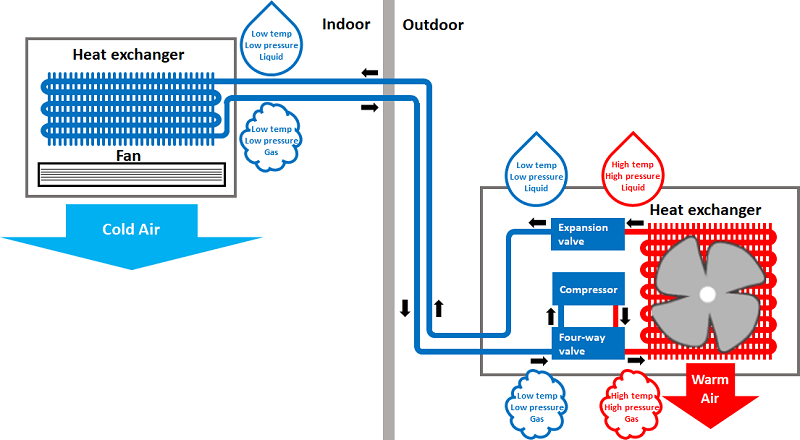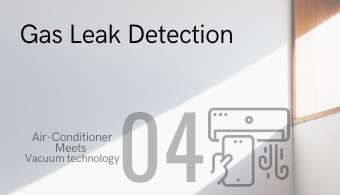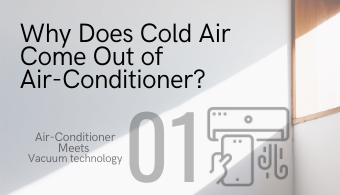Lifestyle
#01 How The Air Conditioner Works

ULVAC Group is a unique corporate group that provides a wide range of comprehensive vacuum technologies, including vacuum systems, vacuum equipment, materials, analytical equipment, and customer solutions, for various industries.
However, you might wonder, "What is the wide range of vacuum technologies?" or "Where in various industries is the vacuum technology used? "
You might be surprised to know that vacuum technology hides in various places around us.
Did you know that vacuum technology is also used in home air-conditioner (Ductless Mini-Split System Air Conditioners), essential to our daily lives throughout the year?
Why Does Cold Air Come Out of Air-Conditioner?
Home air-conditioner is now essential in our lives.For example, 9.81 million units were shipped in 2018 In Japan. The number of units has been increasing every year since 2000, surpassing 1.2 units per house.
In terms of electricity consumption per household, which is equivalent to utility costs, air conditioners account for the 4th largest, 7.4% of the total, after TV. It is no wonder that air conditioner manufacturers are competing in energy-saving technology(*1).
3 Key Points How Air-Conditionings Work
Do you know why cold or warm air comes out from air conditioners? Air-conditioning uses the phenomenon of heat and materials to adjust air temperature.
- Heat moves from higher to lower temperatures.
- Compressing gas raises its temperature -- Adiabatic Compression -- andexpanding gas lowers its temperature -- Adiabatic Expansion.
- The heat is absorbed when a liquid converts into a gas -- Heat ofVaporization --, and the heat is released when a gas converts into a liquid-- Heat of Condensation.
How Cold Air Comes from Air-Conditioners
Air conditioners consist of two main units: an indoor unit and an outdoor unit. The indoor unit has a heat exchanger to transfer the heat of the air to the refrigerant or transfer the heat of the refrigerant to the air.On the other hand, in addition to the heat exchanger, the outdoor unit has a compressor, an expansion valve, and a four-way valve that controls the refrigerant flow direction. And there is a liquid called refrigerant to carry the heat in the pipes that connect the indoor and the outdoor units.
Let's look at how the refrigerant travels in the pipes and how cold air comes out of the air conditioners.
The refrigerant out of the heat exchanger from the indoor unit is a low-temperature and low-pressure gas. The refrigerant travels to the outdoor unit, and the compressor converts it into a high-temperature and high-pressure gas. It is the adiabatic compression.
The fan in the heat exchanger cools the refrigerant. The refrigerant turns into a high-temperature and high-pressure liquid. As the heat is removed from the air, the air is cooled and blown back into the house. It is the heat of condensation.The expansion valve converts the high-temperature and high-pressure liquid refrigerant from the heat exchanger into a low-temperature and low-pressure liquid. It is an adiabatic expansion.
The low-temperature and low-pressure liquid refrigerant travels through the pipes to the indoor unit's heat exchanger. The heat exchanger draws heat from the indoor air as the heat of vaporization, and the refrigerant changes into a low-temperature and low-pressure gas. The heat-deprived air, cold air, comes out of the indoor unit.
- A low-temperature and low-pressure gas refrigerant from the indoor unit's heat exchanger moves to the outdoor unit.
- Adiabatic compression: The compressor converts the low-temperature and low-pressure gas refrigerant into a high-temperature andhigh-pressure gas refrigerant.
- Heat of condensation: The outdoor unit fan cools the high-temperature and high-pressure gas refrigerant, and the refrigerant changes toa high-temperature and high-pressure liquid refrigerant.
- Adiabatic expansion: The expansion valve converts the high-temperature and high-pressure liquid refrigerant changes into a low-temperature and low-pressure liquid refrigerant.
- The low-temperature and low-pressure liquid refrigerant moves from the outdoor unit to the indoor unit.
- Heat of vaporization: The indoor unit's heat exchanger changes the low-temperature and low-pressure liquid refrigerant into a low-temperature and low-pressure gas.
The fan discharges the condensation heat, it is warm, from the outside unit (3). Contrary to it, the refrigerant draws heat from the air, and cold air blows into the house through the inside unit -- a duct box (6).
Air Conditioner applies the principle of refrigerant;
- the refrigerant absorbs heat when a liquid turns into a gas
- the temperature rises when the gas is compressed and changes into a liquid
- the refrigerant releases heat when the gas turns into a liquid
- the temperature lowers when the liquid is expanded and changes into a gas
It is how the air conditioner works and makes your home cooler.
Switching the four-way valve and reverse the refrigerant flow direction, the air conditioner heats the air.

"Leakage" of The Refrigerant is Fatal to The Performance of Air Conditioners.
Performance is Bad? Check Leakage
- The refrigerant circulates through the pipes at extremely high pressure,80 ℃ and 3.2 MPa at high temperature and high pressure, 10 ℃ and 0.9MPa at low temperature and low pressure
- If this refrigerant leaks, the internal pressure will drop, and air conditioners'performance will deteriorate. As a result, the air conditioner doesn't workwell.
- Preventing leakage of the refrigerant is essential for maintaining theperformance of airconditioners.How to avoid leakage? The essential way is leak-test in manufacture. When installing an air conditioner into your house, caution air and moisture in the path the refrigerant through.To keep high performance, pumps out the indoor unit path and inject the refrigerant into it.The installer also tests there is no leak in the pipes.
Glossary
- Refrigerant
It is a gas that circulates between the indoor and outdoor units of air conditioners. It must be resistant to chemical changes because it is compressed and expanded. The refrigerant used in the latest air conditioner is R32, which has zero ozone depletion potential and 1/3 of the global warming potential of the conventional R410A. - MPa (Megapascal)
It is the pressure unit [Pa] (pascal) with M, meaning 106. 1 atm is 0.1MPa, so 3.2MPa is 32 atm, and 0.9MPa is 9 atm.
*1 Source: Ministry of Economy, Trade, and Industry. Working group on Classification Standards for Air Conditioners and Electric Hot Water Appliances, Energy Efficiency and Conservation Subcommittee, Committee on Energy Efficiency and Renewable Energy, Second Advisory Committee for Natural Resources and Energy.
https://www.meti.go.jp/shingikai/enecho/shoene_shinene/sho_energy/air_denki/002.html
Lifestyle
-

Protect nutrients by preventing oxidation with a vacuum chilled
-

#05 Helium Leak Detector
-

#04 Gas Leak Detection Methods
-

#03 Classification of Leak Detection Methods
-

Built-in small diaphragm pump for tasty and long-hour storage
-

#02 The Importance of Refrigerant Leak Detection
-

#01 How The Air Conditioner Works
Solution
- Big Science
- Lifestyle
- Technology
- Medical Field